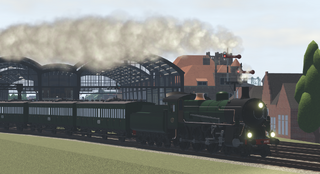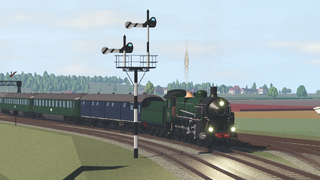 | |
| NS 3600 | |
|---|---|
| by Supersnel11 | |
| Price | ƒ26.000 |
| Level | 7 |
| Statistics | |
| Type | Passenger |
| Top Speed | 110 km/h |
| Weight | 139 tons |
| Capacity | 320 tons |
| Passenger Capacity | 1 first class 2 second class |
| Length | 19,9 meters |
The NS 3600 was a class of Dutch 2'C (4-6-0) express locomotives originally ordered by the Nederlandsche Centraal-Spoorweg-Maatschappij (NCS).
Variants
The NS 3600 is only available in Nederlandsche Spoorwegen green.
Historical details
The NCS years
In 1910, the first 2'C locomotives of both the NCS and Maatschappij tot Exploitatie van de Staatsspoorwegen (SS) were introduced. The locomotives of the NCS were very different from the series 700 of the SS (later NS 3700), as they were based on the S3/5 of the Royal Bavarian State Railway, which Maffei had been building since 1907. The main difference between the 2'Cs of the NCS and those of the Bavarian Railway was that the Bavarian ones were compound locomotives.
The locomotives were delivered in batches of two. NCS 71-72 were delivered in 1910 and the other six in 1911, 1913 and 1914. Their cone-shaped smokebox door (and their pointy cab) got them the nickname "Zeppelins".
In 1911, the NCS and SS came to the agreement of pulling the express Utrecht - Groningen in a single, joined service. Because the NCS owned the tracks between Zwolle (roughly in the middle of the route) to Utrecht, prior to the agreement, the locomotive of one company would have to be swapped for one of the other. After the agreement, the 2'Cs of the NCS pulled the express all the way from Utrecht to Groningen and the 2'Cs of the SS could continue pulling their trains past Zwolle.
The NS years

In 1920, NCS 71-78 were moved to Roosdendaal depot. After receiving new boilers, they were moved to Boxtel. In 1926, they moved again, to Venlo this time, after which they were moved to Nijmegen in 1928. They would remain there until the start of the war. NS modified the 3600s to standardize several of their parts, as shown in the technical details.
WWII
Formally, they were moved to Utrecht in June of 1940, but in reality they were spread all over the country. NS 3608 was used by the Dutch army in a plan to slow down the Germany army and driven off the open bridge over the Willemsvaart near Zwolle Veerallee to block the railway line to Kampen. The 3601 and 3605 were purposefully made to drive into a head-on collision at Helmond, to block that line too. In the summer of 1940, all three were located in the workshops at Tilburg, together with 3606. The four were repaired later that year. Also present was NS 3602, which was irreparably damaged in June of '40. She was not repaired but used for parts to repair the others. She was withdrawn and scrapped, without her tender, in 1947.
It took until January of 1941 for the operational NS 3600s to actually end up at Utrecht.
When the southside of the Netherlands was liberated, NS 3604 was found near Roosendaal, where she would remain until the complete liberation on May 5th, 1945. By then, the others had been relocated to other places. The 3601, 3607 & 3608 were found in the British occupation zone. The 3603 & 3606 were found in the American zone. 3605 ended up on an island in the Soviet occupation zone and did not return, but was scrapped in 1957 in the DDR. NS had already written her off in 1950.
Of the five returning locomotives, only the 3601, 3603 and 3607 were repaired. NS 3606 was supposed to be repaired too, but was withdrawn for scrap shortly after her boiler was removed. The 3606 and 3608 were sent to the scrapyard in early 1947, together with the remains of 3602.
Post-WWII
The four 2'Cs that were left (3601/03/04 & 3607) were not kept in service for long. The services they did pull were irregular; sometimes holiday trains, sometimes facultative sand trains. The 3604 was used in Fijenoord some time in 1950 as the banking locomotive in top-and-tail doubleheaders on heavy trains that crossed the bridges over the Maas.
NS 3601 was withdrawn in 1951, followed by the 3604 and 3607 in 1952. The last was 3603 in 1953.
Technical details
The NCS 71-78 were originally equipped with Westinghouse-brakes (automatic and independent), connections for steam heating on the back of the tender, duplex air pumps from the New York Air Brake Company, a Verloop superheater (71-74) or a Schmidt superheater (75-85), two Gresham & Craven injectors, a Haushälter-speedometer and a sander that only worked on the frontmost driven wheels and only when going forwards.
These locomotives were the first of the Netherlands to use a type of frame previously only used in the United States. The cylinders were of a complicated design. Each external cylinder shared its valve with the inside cylinder next to it, but the steam supplying mechanism and valves were constructed in such a manner that the corresponding drive cranks were 180 degrees opposite of each other.
The cone-shape of the smokebox door was a design aspect taken over from the Bavarian S3/5 on which the 3600s were based.
The tenders of the NCS 71-74 stood on two bogies. The tenders of 75-78 had one bogie; the last two axles were fixed to improve the driving characteristics.
The Verloop superheaters weren't adequate enough, so the NCS 71-74 had theirs replaced with a Schmidt superheater in 1916 and 1917. Between 1919-1924 the full series got a Knorr pre-heater with a heating surface of 13,6 m² and a pump with a capacity of 250 litres per minute. Later, this pump was replaced with a standard one with a capacity of 120 litres per minute. Their original Haushälter-speedometers were replaced with Hasler-speedometers around this time. The New York Air Brake Company air brakes had been replaced with Knorr-compound air brakes at some point prior.

In 1923, NS decided that all boilers of the 3600s would be replaced with those of the same type the NS 3700s had. The most important reason for this decision was the crown stays tendencies to break, often in the left- and rightmost rows. The iconic smokebox door would remain, but the streamlined cabs were lost due to the broad Belpaire firebox. Also lost were the sand domes on top. The sand storage was moved to a space on the exterior walls of the external cylinders. The first to get the new boiler was 3602 in 1924. The 3604 & 3605 followed in 1925. All of the remaining 3600s got their new boiler in 1926, with the exception of 3608, which had to wait until 1927.
NS began with modernising the locomotives even further in 1935. The 3606 got a welded tender which had the same design as the riveted tenders of the NS 3900 series. Additionaly, the bogie was replaced with the type used on the 3900s, and was fitted with brakes. The 3601/02/03 and 3607 were modified the same way in 1936. The 3604 & 3605 were modified in 1937, although the 3605 didn't get her new boiler until 1939. That same year, the 3608 was the last to receive a new tender and bogie.
Their maximum speed was raised to 110 km/h in 1928, likely because the majority had the new boilers by then.
The 3600s had three different mechanisms to inject water into the boiler (two injectors and a pump) until 1938. That year the two small injectors were replaced with a single, larger one, also from Gresham & Craven.
Trivia
- Despite being almost identical mechanically, the NS 3600 is very much inferior to the NS 3700.
- The NS 3600 was the first locomotive to receive Walschaerts valve gear, driven off the front-most axle.
- The NS 3600 has been available since launch, version 0.1.
Gallery
-
An NS 3600 leaving Voorlem with a set of C8c coaches.
-
NS 3607 waiting at the Voorlem entrance signal for the platform to clear.


